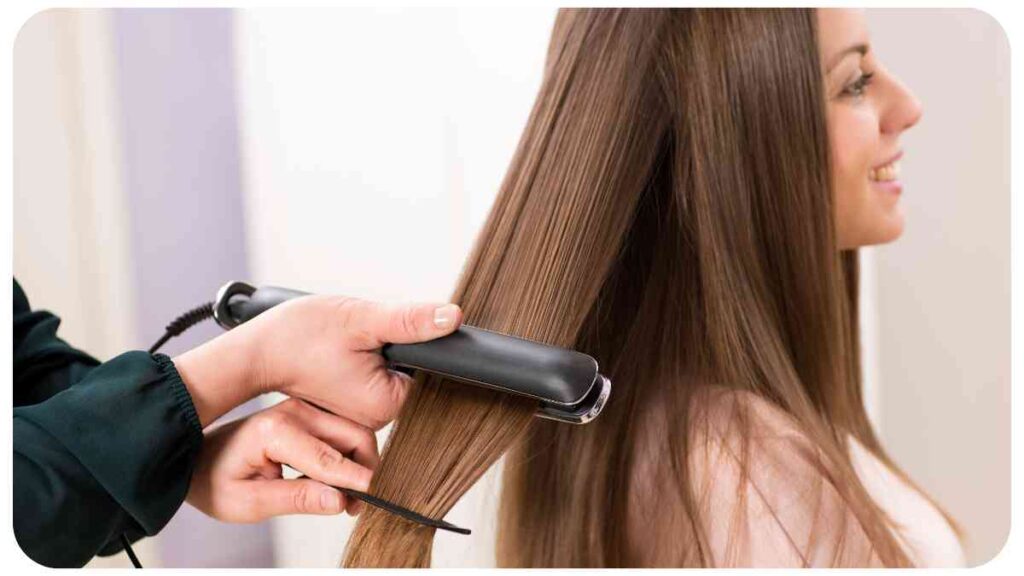Welcome to the ultimate guide on troubleshooting your flat iron. If you’re facing issues with your favorite hair styling tool, don’t panic! In this article, we will discuss common problems that occur with flat irons and provide tips and solutions to help you fix them.
Whether your flat iron isn’t heating up properly, causing damage to your hair, or leaving unwanted dents, we’ve got you covered. Let’s dive in and learn how to troubleshoot these issues like a pro.
| Takeaways |
| 1. Troubleshoot common flat iron problems with proper temperature adjustment and technique. |
| 2. Clean the plates regularly to maintain optimal heat distribution and performance. |
| 3. Adjust heat settings according to your hair type to avoid damage and dents. |
| 4. Use a heat protectant spray to shield your hair from heat styling. |
| 5. Implement proper flat iron maintenance and care for longevity and optimal performance. |
| 6. Choose the right flat iron based on your hair type, considering plate materials, size, and shape. |
| 7. Never use a flat iron on wet hair to prevent damage. |
| 8. Clean your flat iron regularly with rubbing alcohol or a vinegar-water mixture. |
| 9. Store your flat iron in a safe and dry location, ensuring it’s completely cooled down. |
| 10. Perform regular inspections and maintenance to identify and fix any potential issues. |
Understanding the Flat Iron
What is a Flat Iron?
A flat iron, also known as a hair straightener, is a popular styling tool used to straighten and smoothen hair. It consists of two heated plates that clamp down on the hair strands, applying heat to straighten them. Flat irons come in various sizes, materials, and features to cater to different hair types and styles.
Different Types of Flat Irons
Before we delve into troubleshooting, let’s familiarize ourselves with the different types of flat irons available in the market. Understanding their features will help you choose the right one for your hair type:
| Type | Features |
| Ceramic Flat Iron | Provides even heat distribution, suitable for most hair types |
| Tourmaline Flat Iron | Emits negative ions, reduces frizz and adds shine |
| Titanium Flat Iron | Heats up quickly, ideal for thick and coarse hair |
| Ionic Flat Iron | Emits negative ions to neutralize positive ions, reduces frizz |
| Steam Flat Iron | Releases steam, adds moisture to the hair |
Now that you know the basics, let’s move on to troubleshooting common flat iron problems.
Common Flat Iron Issues and Solutions
Flat Iron Not Heating Up
Is your flat iron not heating up, leaving you frustrated? There could be a simple solution to this problem. Firstly, ensure that the power source is working properly. Check if the power cord is securely plugged in and there are no loose connections. Additionally, make sure that the power outlet is functioning by plugging in another device.
If the power source seems fine, the flat iron’s heating elements might be damaged. In such cases, it is best to consult a professional or contact the manufacturer for repairs.
If you’ve ever encountered a broken eyeshadow palette, don’t despair! With our step-by-step guide, you can fix it like a pro. Learn the simple techniques to restore your favorite shades and continue creating amazing eye makeup looks.
Uneven Heat Distribution
Uneven heat distribution can lead to unsatisfactory results when straightening your hair. To troubleshoot this issue, first, clean the plates of your flat iron. Over time, product buildup can affect the heat distribution. Gently wipe the plates with a damp cloth or use a specialized plate cleaner to remove any residue.
If cleaning doesn’t solve the problem, the heating elements inside the flat iron might be damaged. In that case, professional repairs or replacement may be necessary.
Snagging or Pulling Hair
If your hair gets stuck or pulled while using the flat iron, it can be quite painful and damaging. This issue often occurs when the plates aren’t smooth. Look closely at your flat iron’s plates and check for any rough edges or snags. If you notice any irregularities, it might be time to invest in a new flat iron with smoother plates.
Alternatively, you can try using a heat protectant spray before straightening your hair. This will create a barrier between your hair and the plates, reducing friction and preventing snagging.
Flat Iron Leaving Dents
Are you frustrated with your flat iron leaving unsightly dents in your hair? This issue commonly arises when the flat iron is too hot or is clamped down on the hair for too long. To fix this problem, start by adjusting the heat settings on your flat iron.
Lower the temperature and test the flat iron on a small section of hair to ensure it doesn’t leave any dents. It’s essential to find the right balance between heat and time to achieve smooth results without causing dents.
Additionally, consider the technique you’re using while straightening your hair. Instead of clamping the flat iron down tightly on your hair, try gliding it smoothly through the strands for a more even and dent-free look. Remember to maintain a consistent speed and avoid pausing at one spot for too long.
Now that we’ve discussed common flat iron problems and their solutions, let’s explore some troubleshooting tips to help you resolve these issues effectively.
Troubleshooting Tips for Flat Iron Problems

Check the Power Source
When your flat iron isn’t heating up or functioning properly, start by verifying the power source. Ensure that the power cord is securely connected to both the flat iron and the outlet. Check if there are any loose connections or frayed wires that may be causing the issue. If necessary, try plugging the flat iron into a different outlet or use an extension cord to rule out any power source problems.
Clean the Plates
Regularly cleaning the plates of your flat iron is crucial for maintaining its performance. Product buildup, oils, and residue can accumulate on the plates over time, affecting their ability to distribute heat evenly. Take a soft cloth or a cotton ball soaked in rubbing alcohol and gently wipe the plates. This will remove any residue and ensure optimal heat distribution.
Are you facing issues with your hair straightener? Don’t worry, our quick guide provides solutions to common problems. Discover troubleshooting tips and techniques to ensure your hair straightener always delivers sleek, beautiful results
Adjust the Heat Settings
If you’re experiencing issues with the temperature or the flat iron leaving dents, it’s important to adjust the heat settings. Experiment with different temperature levels and find the one that works best for your hair type. Fine or delicate hair might require lower heat settings, while thick or coarse hair may need higher temperatures for effective straightening.
Remember, it’s better to start with lower heat and gradually increase if needed, rather than using excessively high temperatures that can damage your hair. Don’t forget to consult the user manual of your flat iron for specific temperature guidelines.
Use a Heat Protectant Spray
Using a heat protectant spray is highly recommended to shield your hair from the damaging effects of heat styling. Before using the flat iron, generously apply a heat protectant spray to your hair, focusing on the mid-lengths and ends. This will create a barrier that minimizes heat damage and keeps your hair healthy.
Heat protectant sprays not only provide thermal protection but also help with detangling and adding shine. Look for a spray that suits your hair type and provides the level of protection you desire.
Now that we have covered troubleshooting tips, let’s delve into flat iron maintenance and care to ensure longevity and optimal performance.
Struggling with pigmentation issues? Our skincare routine can help you tackle this concern. Discover effective steps, recommended products, and expert tips to combat pigmentation and achieve a more even, radiant complexion.
Flat Iron Maintenance and Care
Cleaning Your Flat Iron
Regular cleaning is essential to keep your flat iron in top condition. Following a few simple steps will help maintain its longevity and performance. Firstly, make sure the flat iron is unplugged and has cooled down completely.
Take a clean cloth or cotton ball soaked in rubbing alcohol and gently wipe the plates. This will effectively remove any product buildup or residue. For stubborn buildup, you can use a mixture of equal parts water and vinegar, applied with a cloth or cotton ball.
Be careful not to use abrasive materials or excessive force that may scratch or damage the plates. Once you’ve cleaned the plates, use a dry cloth to wipe away any remaining moisture before storing the flat iron.
Storing Your Flat Iron
Proper storage of your flat iron is essential to prevent damage and prolong its lifespan. After cleaning and drying the plates, make sure to store the flat iron in a safe and dry location.
Some flat irons come with a heat-resistant storage pouch or a built-in holder. If yours doesn’t, consider investing in a heat-resistant mat or pouch to protect the flat iron and other surfaces from heat damage. Always ensure that the flat iron is completely cooled before storing it to avoid any accidents or hazards.
Regular Inspection and Maintenance
Performing regular inspections and maintenance will help you identify any potential issues with your flat iron in a timely manner. Check the power cord for any signs of wear or damage and replace it immediately if needed. Inspect the plates for any rough edges, snags, or discoloration that may affect their performance.
Refer to the user manual provided by the manufacturer for specific instructions on maintenance and troubleshooting. If you encounter any persistent issues that cannot be resolved through troubleshooting, it’s advisable to consult a professional or contact the manufacturer for further assistance.
It’s crucial to choose the right flat iron for your hair type to ensure optimal results and minimize potential damage. Let’s explore the factors to consider when selecting a flat iron.
Leather boots add a touch of sophistication to any outfit. To keep them looking their best, follow our comprehensive maintenance guide for tips on cleaning, conditioning, and storing your boots. Preserve their quality and enjoy your stylish footwear for years to come
Choosing the Right Flat Iron for Your Hair
Consider Your Hair Type
Different hair types require different heat settings and plate materials. Fine or damaged hair typically benefits from lower heat settings, while thick or coarse hair might need higher temperatures for effective straightening. Consider the texture, thickness, and overall condition of your hair when choosing a flat iron.
Plate Materials
The material of the plates plays a significant role in the performance of a flat iron. Here are some common plate materials and their characteristics:
- Ceramic Plates: Provide even heat distribution and gentle styling, suitable for most hair types.
- Tourmaline Plates: Emit negative ions, reduce frizz, and add shine to the hair.
- Titanium Plates: Heat up quickly and evenly, ideal for thick and coarse hair.
- Ionic Plates: Emit negative ions that neutralize positive ions in the hair, resulting in reduced frizz and static.
- Steam Plates: Release steam that adds moisture to the hair while straightening.
Consider your hair type and the result you want to achieve when selecting the plate material that suits you best.
Size and Shape of the Flat Iron
The size and shape of the flat iron also play a role in its performance on different hair lengths and styles. Here are some general guidelines:
- Narrow Plates (around 1 inch): Ideal for short hair, bangs, or styling close to the roots.
- Medium Plates (around 1.5 to 2 inches): Versatile size suitable for medium-length to long hair.
- Wide Plates (2 inches or larger): Best for thick, long, or curly hair that requires wider sections for straightening.
Consider your hair length and the desired styling options when selecting the size and shape of the flat iron.
Now that you have a good understanding of how to troubleshoot and resolve flat iron problems, as well as tips for maintenance and choosing the right flat iron, let’s address some frequently asked questions.
Want to upgrade your makeup collection? Check out our selection of must-try makeup products that are trending right now. From foundations to eyeshadows, find the perfect additions to your beauty routine and achieve stunning, flawless looks.
Frequently Asked Questions (FAQs)
Can I use a flat iron on wet hair?
No, it is not safe to use a flat iron on wet hair. Wet hair is more vulnerable to heat damage, and using a flat iron on wet or damp hair can cause severe damage, such as sizzling, frizz, and breakage. Always make sure your hair is completely dry before using a flat iron to prevent any harm.
How often should I clean my flat iron?
Regular maintenance and cleaning are essential for the longevity and performance of your flat iron. As a general guideline, it’s recommended to clean the plates of your flat iron after every use or at least once a week, depending on how frequently you use it and the product buildup. However, always refer to the manufacturer’s instructions for specific cleaning recommendations.
Can a flat iron cause hair damage?
Excessive or improper use of a flat iron can cause hair damage. High heat settings, frequent use without heat protectant products, and clamping the flat iron down for too long can lead to dryness, split ends, and even breakage. To minimize damage, follow the manufacturer’s instructions, choose suitable heat settings for your hair type, and use heat protectant sprays or serums before styling.
Now that you’re equipped with troubleshooting tips, maintenance guidelines, and answers to common questions, you should feel confident in your ability to troubleshoot and fix common flat iron problems. Remember to prioritize safety, be mindful of your hair type, and use proper techniques to achieve the desired results without compromising the health of your hair.
Conclusion
Troubleshooting your flat iron doesn’t have to be a daunting task. By understanding the common problems and their solutions, following proper maintenance and care practices, and choosing the right flat iron for your hair type, you can overcome any challenges you encounter. Remember to always prioritize safety, protect your hair from heat damage, and enjoy the versatility of your flat iron for beautiful, straight hair.
Further Reading
Here are some additional resources you can refer to for more information on troubleshooting and repairing common flat iron problems:
Steps to Repair Common Iron Problems: This article provides step-by-step instructions on how to troubleshoot and fix common problems that occur with flat irons. It covers issues like no power, uneven heating, and plate problems.
Common Trouble of a Flat Iron: In this document, you’ll find a detailed overview of common issues that can arise with flat irons. It offers troubleshooting tips and solutions for problems like temperature inconsistencies, plate damage, and more.
Flat Iron Repair Guide: If you’re looking for a comprehensive guide on repairing flat irons, this resource from iFixit offers detailed instructions, troubleshooting tips, and even replacement parts. It covers a wide range of models and provides step-by-step repair guides.
FAQs
Below are some frequently asked questions about flat irons:
Can I straighten my hair with a wet flat iron?
No, it is not safe to use a flat iron on wet or damp hair. Wet hair is more susceptible to heat damage, and using a flat iron on wet hair can cause sizzling, frizz, and potential damage to your hair strands.
How often should I clean my flat iron?
To keep your flat iron performing at its best, it’s recommended to clean the plates after each use or at least once a week, depending on the frequency of use and product buildup. Cleaning helps remove residue and ensures even heat distribution.
Can I use a flat iron on all hair types?
Yes, flat irons can be used on various hair types, including straight, wavy, and curly hair. However, it’s important to select a flat iron with adjustable temperature settings and use appropriate heat levels for different hair types to minimize damage and achieve desired results.
How do I prevent heat damage when using a flat iron?
To minimize heat damage when using a flat iron, it’s important to use a heat protectant spray or serum before styling. Additionally, start with the lowest heat setting suitable for your hair type and gradually increase if needed. Avoid excessive heat exposure by quickly and smoothly gliding the flat iron through your hair.
How do I store my flat iron properly?
After each use, allow your flat iron to cool down completely before storing it. Store it in a safe and dry place, away from water or flammable materials. If your flat iron has a heat-resistant storage pouch or holder, use it to protect the plates and prevent any accidents.

Hi, you! I’m Hellen James. I’m a beauty and fashion writer who loves to make the world a little more stylish and I’d love for you to join me in the fun! I’ve been writing about beauty and fashion since I was a kid, but it wasn’t until recently that I really knew what it meant to be a real expert.

